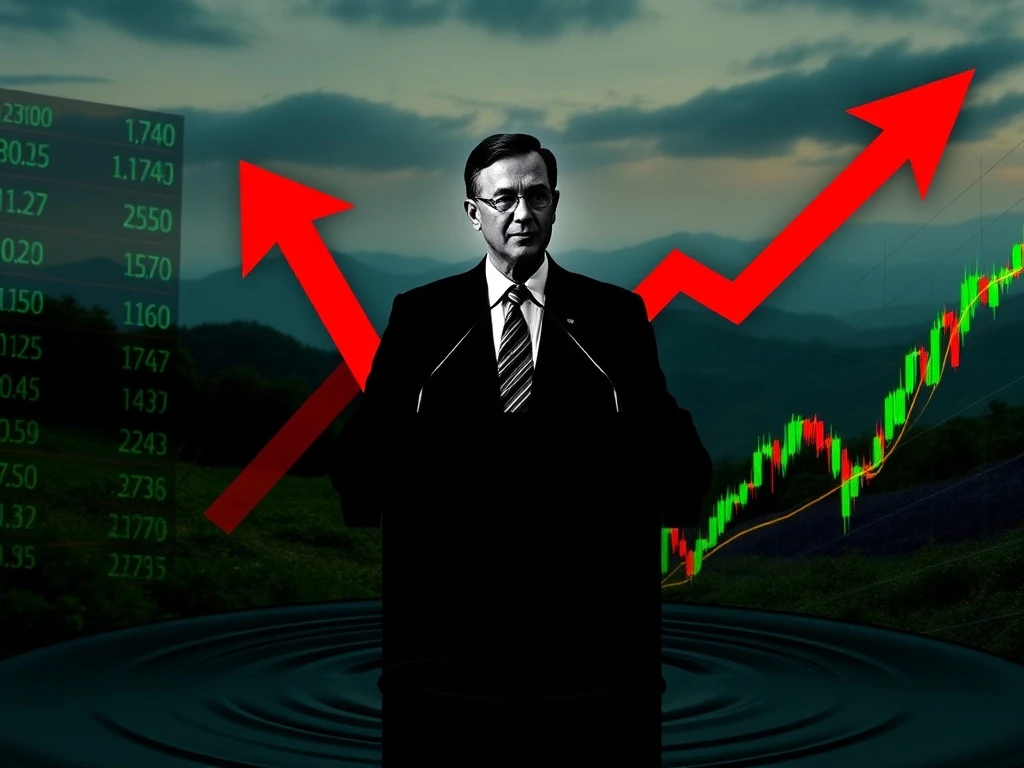Investors closely monitor every announcement from the Federal Reserve. Indeed, these messages often trigger significant market movements. Recent remarks from Fed Chair Jerome Powell on **Fed interest rates** provide a clear example. His latest update sent immediate shockwaves through global stock markets. This analysis delves into the market’s sharp response and the underlying reasons.
Fed Interest Rates and Market Volatility
Federal Reserve Chair Jerome Powell recently delivered a pivotal message. He addressed the future trajectory of **Fed interest rates**. Consequently, stock markets reacted sharply. Investors digested his comments, leading to notable shifts in trading patterns. Powell’s remarks typically guide market expectations for monetary policy. Therefore, their impact is always significant.
The market’s reaction was swift and pronounced. Equity indices saw considerable fluctuations. Some sectors experienced sell-offs, while others showed resilience. This volatility reflects the deep connection between monetary policy and corporate valuations. When the Fed signals its intentions, market participants adjust their strategies accordingly. They anticipate future borrowing costs and economic growth prospects. Therefore, understanding these signals is crucial for all investors.
Key Takeaways from Powell’s Message on Fed Interest Rates:
- Inflation Focus: Powell reiterated the Fed’s commitment to bringing inflation down to its 2% target.
- Data Dependency: Future decisions on **Fed interest rates** will remain highly dependent on incoming economic data.
- Higher for Longer: The message suggested that rates might stay elevated for an extended period.
- Economic Resilience: The Fed acknowledged the economy’s surprising strength, which complicates the inflation fight.
Understanding the Federal Reserve’s Stance on Fed Interest Rates
The Federal Reserve plays a critical role in the U.S. economy. It aims to maintain maximum employment and stable prices. Achieving these goals often involves adjusting **Fed interest rates**. The federal funds rate is the primary tool. It influences borrowing costs across the entire economy. Therefore, changes to this rate affect everything from mortgages to corporate loans.
Several factors guide the Fed’s decisions. Inflation data remains a top priority. Strong employment figures also factor into their assessments. Furthermore, global economic conditions and financial stability risks influence their outlook. The Fed constantly evaluates these indicators. Their goal is to strike a delicate balance. They seek to cool inflation without causing a severe recession. This balancing act makes every announcement highly anticipated.
How Monetary Policy Influences Stock Markets:
Monetary policy directly impacts corporate profitability and investor sentiment. Here’s how:
- Borrowing Costs: Higher **Fed interest rates** increase the cost of borrowing for businesses. This can reduce investment and expansion plans.
- Consumer Spending: Elevated rates can curb consumer spending. Consumers face higher costs for loans and credit.
- Discount Rates: Investors use discount rates to value future earnings. Higher rates make future earnings less valuable today.
- Alternative Investments: Rising rates make bonds more attractive. This draws money away from riskier assets like stocks.
The Immediate Impact of Fed Interest Rates on Stocks
Powell’s recent remarks immediately impacted various stock market sectors. Growth stocks, particularly in technology, often feel the pinch most. These companies rely heavily on future earnings potential. Higher **Fed interest rates** reduce the present value of those future earnings. Therefore, their valuations can suffer significantly.
Conversely, value stocks or sectors less sensitive to borrowing costs might fare better. Financial institutions, for instance, sometimes benefit from higher net interest margins. Energy and utility stocks can also offer more stability during periods of rising rates. However, the overall market trend often leans bearish when rates are expected to climb. Investors typically re-evaluate their portfolios. They seek assets that offer better returns in a higher-rate environment.
Sectoral Reactions to Changing Fed Interest Rates:
- Technology (Growth Stocks): Often decline as higher rates diminish the present value of future earnings.
- Financials: Can see mixed reactions; higher rates may boost net interest margins but could also increase loan defaults.
- Utilities/Consumer Staples (Defensive Stocks): Tend to be more stable as their earnings are less sensitive to economic cycles.
- Real Estate: Typically struggles as mortgage rates rise, dampening housing demand and property values.
Investor Sentiment and Future Outlook for Fed Interest Rates
Investor sentiment is a powerful force in the markets. Powell’s communication shapes this sentiment profoundly. A ‘hawkish’ message, suggesting tighter policy, often leads to investor caution. Conversely, a ‘dovish’ tone, indicating looser policy, can spark optimism. The latest message leaned hawkish, reinforcing the idea of sustained higher **Fed interest rates**. This outlook has made investors more risk-averse.
Forward guidance from the Fed is critical. It provides clues about future policy moves. Investors scrutinize every word for hints about upcoming rate hikes or cuts. The market tries to price in these probabilities. This constant adjustment creates short-term volatility. Ultimately, the Fed’s credibility also plays a role. If markets trust the Fed’s ability to manage the economy, reactions might be more measured. However, uncertainty often breeds sharp movements.
Key Factors Influencing Future Fed Decisions:
The path of **Fed interest rates** is not set in stone. Several key economic indicators will guide future decisions:
- Inflation Data: Consumer Price Index (CPI) and Personal Consumption Expenditures (PCE) reports are crucial.
- Employment Reports: Non-farm payrolls, unemployment rates, and wage growth provide insights into labor market strength.
- GDP Growth: Economic growth figures indicate the overall health of the economy.
- Global Economic Trends: International developments can also influence the Fed’s perspective.
Navigating the Market Amidst Changing Fed Interest Rates
Investors must adapt their strategies to a dynamic environment. When **Fed interest rates** are in flux, traditional approaches might need re-evaluation. Diversification remains a cornerstone of prudent investing. Spreading investments across different asset classes and sectors can mitigate risk. Furthermore, focusing on companies with strong balance sheets and consistent cash flow becomes paramount. These firms are often better equipped to handle higher borrowing costs.
Risk management is also essential. This includes setting clear investment goals and understanding personal risk tolerance. Avoiding speculative bets during periods of high uncertainty is often wise. Instead, a focus on long-term value and quality assets can provide more stability. Staying informed about economic data releases is also crucial. This allows investors to anticipate potential shifts in Fed policy. Consequently, they can make more informed decisions.
Strategies for Investors in a Rising Rate Environment:
- Focus on Quality: Invest in companies with robust financials and strong market positions.
- Consider Value Stocks: These may outperform growth stocks when rates are higher.
- Explore Shorter-Duration Bonds: They are less sensitive to interest rate changes than long-duration bonds.
- Diversify Broadly: Spread investments across various asset classes and geographies.
Historical Precedents for Fed Interest Rates Decisions
History offers valuable lessons regarding **Fed interest rates** cycles. The Federal Reserve has navigated numerous periods of inflation and economic adjustment. During the 1970s and early 1980s, for example, aggressive rate hikes were necessary to curb runaway inflation. These periods often saw significant market volatility and, at times, economic recessions. However, they ultimately led to price stability.
More recently, the post-2008 financial crisis era saw prolonged periods of near-zero interest rates. This policy aimed to stimulate economic recovery. The subsequent tightening cycle, which began in 2022, represents a return to more conventional monetary policy. Understanding these historical patterns helps investors contextualize current events. It provides perspective on how markets typically react to changes in monetary policy. While every cycle is unique, past experiences offer important insights.
In conclusion, Jerome Powell’s latest message on **Fed interest rates** clearly impacted stock markets. The market’s sharp response underscores the Federal Reserve’s immense influence. Investors must remain vigilant, paying close attention to economic data and future Fed communications. Adapting investment strategies to this evolving landscape will be key for navigating the path ahead successfully.
Frequently Asked Questions (FAQs)
Q1: Why do stock markets react so strongly to Fed interest rates announcements?
Stock markets react strongly because **Fed interest rates** directly influence borrowing costs for businesses and consumers. Higher rates can reduce corporate profits, make future earnings less valuable, and shift investor preference towards safer assets like bonds. This impacts stock valuations and investor sentiment significantly.
Q2: What is the difference between a ‘hawkish’ and ‘dovish’ Fed message regarding Fed interest rates?
A ‘hawkish’ message indicates the Fed is inclined to raise or maintain high **Fed interest rates** to combat inflation. A ‘dovish’ message suggests the Fed is more focused on supporting economic growth, potentially by lowering or holding rates steady.
Q3: How do rising Fed interest rates affect different types of stocks?
Rising **Fed interest rates** generally hurt growth stocks (e.g., tech) more, as their valuations depend heavily on future earnings. Value stocks and defensive sectors (e.g., utilities, consumer staples) often show more resilience. Financial stocks can see mixed effects, potentially benefiting from higher net interest margins but facing increased loan default risks.
Q4: What economic data does the Fed consider when deciding on Fed interest rates?
The Federal Reserve considers a range of economic data. Key indicators include inflation (CPI, PCE), employment figures (non-farm payrolls, unemployment rate, wage growth), and GDP growth. They also monitor global economic conditions and financial stability risks.
Q5: What strategies can investors use to navigate periods of changing Fed interest rates?
Investors can employ several strategies. These include diversifying portfolios across various asset classes, focusing on companies with strong balance sheets, considering value stocks over growth stocks, and exploring shorter-duration bonds. Staying informed about economic data and Fed communications is also crucial.
















